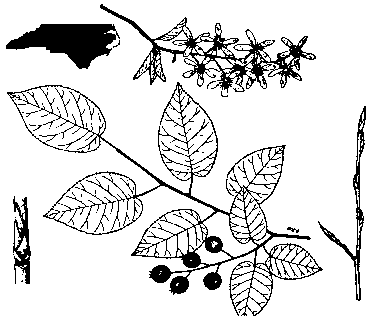|
Serviceberry
(Amelanchier
arborea (Mickx. f Fern)
|
|
| |
 |
|
| |
Serviceberry also is known as service-tree or shadbush. In North
Carolina, it is called "sarvis." It is found throughout the state
but develops best on mountain slopes. The common name of shadbush
was given to the tree by early settlers, who associated its blooming
with April shad runs. It is a small tree, 2 to 50 feet high and
1/2 to 1 1/2 feet in diameter, with a rather narrow, rounded top.
Often, it is little more than a shrub.
The thin, ashy gray bark is smooth on the branches and upper part
of the stem and breaks into shallow fissures on the short trunk.
The leaves are alternate, slender-stalked, ovate, pointed, finely
toothed, 2 to 4 inches long and purplish-brown until nearly mature.
When mature, the leaves become light green. Young leaves are covered
with scattered silky hairs.
The terminal buds are long and pointed but are smaller than those
of beech. The white flowers appear in standing or drooping clusters
in early spring -- before or with the leaves -- making the tree
noticeable in the leafless or budding forest.
The fruit is sweet, edible, rounded, one-third to one-half an
inch in diameter and dark purple to black when ripe -- in early
June. Most birds and animals of the forest eat the serviceberry
fruit.
The wood is heavy, extremely hard, strong, close-grained and dark
brown. It occasionally is used for furniture and turnery. Serviceberry
is a desirable ornamental tree. |
|
|

